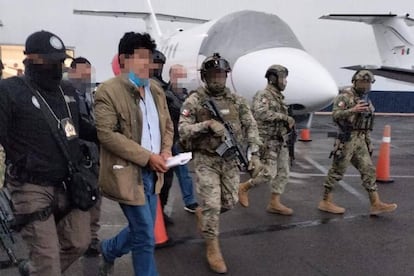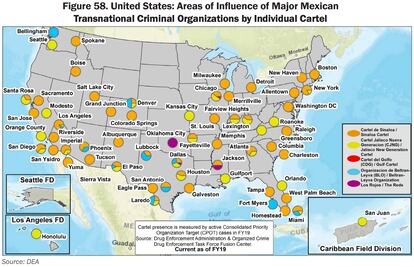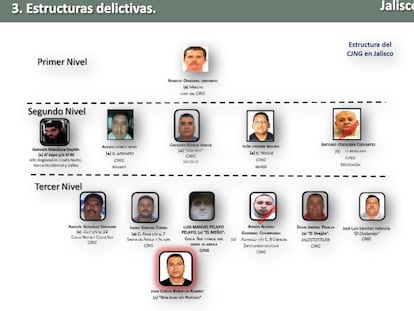Caro Quintero, Los Zetas: US prioritizing extradition of notorious drug lords, Mexican leaked security emails show
White House asked government of López Obrador for a quota of 60 extraditions a year and provided a list of priority targets as part of Bicentennial Framework talks, according to Sedena documents that EL PAÍS has seen

The Narco of Narcos was surrounded by more than a dozen marines. Rafael Caro Quintero was wearing blue pants, a blue shirt and a beige overcoat when he was captured in the small community of Choix, in the Sinaloa mountains. The authorities did not want to run any risks: the instructions were to transfer him by plane directly from that location near the Pacific coast to the maximum security prison of the Altiplano, in central Mexico. Images of the operation spread like wildfire on the afternoon of July 15: Caro Quintero drinking from a bottle of water that he was given during the arrest; Caro Quintero looking defeated on board an aircraft, and finally, walking slowly, escorted and handcuffed, after landing in Mexico City. It was the most high-profile capture of a drug trafficker so far under the administration of Andrés Manuel López Obrador.
Five months earlier, the White House had put down in writing that it wanted Mexican authorities to expedite procedures to extradite Caro Quintero, even though the drug baron was still at large at that point. Washington not only put extradition on the bilateral negotiating table but also set a date for the request: “To be processed before July 1, 2022.” The Joe Biden administration also put a figure on the number of extradited individuals that it demanded from the Mexican authorities: “Return general extraditions to the historical average of 60 per year in 2022.” This information was gleaned from several working documents that are part of the Bicentennial Framework for Security, Public Health, and Safe Communities, the security plan that both countries announced in October 2021 and which includes other high-profile drug traffickers, according to hacked emails from Mexico’s Secretariat of National Defense (Sedena), which EL PAÍS has had access to.

The United States wish list included Abigael González Valencia, aka El Cuini, right-hand man and brother-in-law of the founder of the Jalisco New Generation Cartel (CJNG), Nemesio Oseguera Cervantes, El Mencho. The US also requested the extradition of the brothers Miguel Ángel Treviño Morales, known as Z-40, and Omar Treviño Morales, known as Z-42, founders of Los Zetas, considered one of the most bloodthirsty criminal groups in Mexico and thought to be responsible for the murder of 72 migrants in San Fernando, Tamaulipas. Another one of the targets is identified only as “Villarreal” and could possibly be José Rodolfo Villarreal Hernández, El Gato, boss of the Beltrán Leyva Cartel and included in the list of the FBI’s 10 Most Wanted Fugitives in 2020. Caro Quintero’s name also appeared on that list.
“The governments of the United States and Mexico regularly collaborate on extradition requests. The US government is excited to increase our shared security cooperation under the Bicentennial Framework,” said a spokesperson for the US Embassy in Mexico who declined to comment further. A spokesman for the Mexican Foreign Ministry said that bilaterally there is a new focus on strategic extraditions for each country: for the US, the priority is on the leaders of drug trafficking, with special emphasis on fentanyl; for Mexico it is the individuals linked to arms trafficking and diverting public funds. The official, who asked to keep his name confidential, said that from 2023 the request for extraditions to Mexico for these crimes will be accelerated. This newspaper also reached out to Sedena for comment, but did not receive a response.
All the drug lords wanted by the US are being held in Mexican prisons, with the exception of El Gato Villarreal, who is still at large. In almost all cases, Mexican and US authorities have tried to extradite them, so far without success. The trials have been bogged down by injunctions filed by the legal defense of the drug traffickers.
According to US court documents obtained by this newspaper, Caro Quintero is wanted in California for the murder of DEA agent Enrique Kiki Camarena in the 1980s. The drug lord has three other open cases in Texas, Arizona and New York for drug trafficking. Although an extradition trial was initiated after his capture, the process is bogged down as appeals and other legal resources used by his lawyers get resolved. So far no specific date has been announced for his extradition to the US.
El Cuini was accused by the US in November 2013 of acting in collusion with El Mencho to import and distribute cocaine, methamphetamine and marijuana in that country, as well as in Colombia, Guatemala, Ecuador and Mexico, between 2000 and 2014. They were accused of committing murders, kidnappings, acts of torture and of bribing authorities. Abigael González Valencia is identified in the suit as the leader of Los Cuinis, a criminal organization allied with the CJNG. He was captured in February 2015 and since then he has been imprisoned, first in the Altiplano penitentiary, in the State of Mexico, and then in Oriente prison, in the country’s capital. El Cuini is the brother of Rosalinda González Valencia, wife of El Mencho and who was also arrested in November of last year.
After the capture of El Cuini, the Mexican government issued two agreements favorable to his extradition, one in 2016 and the other in 2019. In the end, both attempts were reversed by decisions of federal judges. The penetration of the CJNG in the US has triggered security alerts in that country. According to a 2019 report from the DEA, the US anti-drug agency, the Mencho criminal organization has a presence in 26 cities, in a clear territorial dispute with the Sinaloa Cartel, which is present in 49. The report provides an account of other Mexican criminal organizations with less penetration in US territory, such as the Gulf Cartel, Los Beltrán Leyva, Los Rojos, Los Zetas (or Cartel del Noreste), Guerreros Unidos, Cartel de Juárez (or La Línea) and La Familia Michoacana.

The situation of the Treviño Morales brothers is similar to that of El Cuini: after being arrested, both have managed to block their extraditions. The first to fall was Miguel Ángel, Z-40, then leader of Los Zetas, in a Navy operation carried out in Nuevo Laredo, Tamaulipas, in 2013. After his capture, his brother Oscar Omar, Z-42 , assumed the leadership of the criminal organization. Two years later, he too was arrested, this time by the Army. The first is being held in a federal prison in Chiapas and the second in one in Sonora.
Both drug lords were accused by the US in 2012 of conspiracy to launder money from the illegal sale of drugs in that country, mainly cocaine and marijuana, according to court documents consulted by this newspaper. The indictment, which involves 13 other people, states that the drugs were first introduced into Mexico from Colombia and Venezuela through ships, planes and cars, and then moved to Texas.
From there, the Treviño Morales brothers laundered assets in the US by buying quarter horses and betting on horse races – a legal activity – with the support of relatives who lived in that country. “Proceeds from the illegal sale of narcotics in the United States would be transported to Mexico through shipments of cash. Those shipments would be delivered to [Los Zetas] bosses for further distribution in order to continue the illegal distribution of drugs and to launder proceeds through various activities,” the lawsuit says. The legal defenses of both Z-40 and Z-42 have filed injunctions against their extradition to the United States.

José Rodolfo Villarreal Hernández, El Gato, another US extradition target, is wanted by the FBI for having ordered the murder of the lawyer of Osiel Cárdenas Guillén, founder of the Beltrán Leyva Cartel. The local boss of this criminal organization in Monterrey and San Pedro Garza García, in Nuevo León, El Gato allegedly hired hitmen to carry out the murder, which occurred in May 2013 outside a shopping mall in Southlake, Texas, in full daylight. In October 2020, his name was included on the list of the FBI’s most wanted fugitives, along with that of another capo also accused of murder: Caro Quintero.
An exchange of emails between the US authorities and officials from the Secretariat of Foreign Affairs (SRE) and Sedena sheds light on how the priority actions for both governments were defined as part of the Bicentennial Framework, the bilateral collaboration scheme that replaced to the Merida Initiative. The actions are grouped into three general themes that were made public from the beginning: “Protect our people”, “Prevent cross-border crimes” and “Pursue criminal networks.” The Sedena leak, however, brings to light what the specific indicators are to measure progress on each goal.
The case of extraditions is grouped in the persecution of criminal groups as an indicator and it is always viewed in one direction: “Increase the number of extraditions of wanted fugitives from Mexico to the United States.” The SRE spokesman did not comment on this statement, but suggested that more extraditions from the US to Mexico will begin to take place starting in 2023.
The documents under review show that Washington also demanded an increase in the number of court cases filed against drug traffickers and in the number of convictions. In the public version of these action plans, the tone changes: there is no talk of achieving convictions or reaching a quota of extraditions, but of “increasing cooperation in extradition matters.” The extraditions are the last point mentioned in the official communications.
In 2021 there were 43 extraditions from Mexico to the United States, the lowest number in the last 15 years, according to a report by the US Congress published this year. Data from the Department of Justice show how extraditions skyrocketed during the government of Felipe Calderón (2006-2012) to an average of 98 extraditions per year, almost triple the 35 averaged by the administration of Vicente Fox (2000-2006) , at the beginning of the so-called war against drugs. Under Enrique Peña Nieto (2012-2018), the average fell to 65 extraditions per year. López Obrador’s six-year term began with the same inertia: there were 58 in 2019 and 60 in 2020, before collapsing last year, according to official statistics.
The emphasis on extraditions that were made in private helps to understand the statements that were made in public. Barely a week after the capture of Caro Quintero, US Attorney General Merrick Garland held a call with Marcelo Ebrard, the Mexican foreign minister, to finalize his extradition. “Both leaders reaffirmed their commitment to work expeditiously on the extradition of Caro Quintero,” reads the official statement.
US Ambassador Ken Salazar has also insisted. During a visit to Colima, one of the hot spots of violence in Mexico, Salazar met with Governor Indira Vizcaíno to discuss the security crisis and publicly called for increased extraditions of defendants and criminals. “We want them in the United States, send them to us as soon as possible,” the ambassador said on August 9, just a few hours before the CJNG imposed chaos with several drug blockades in Jalisco, while the authorities tried to capture a regional chief. “That is a very effective way to have an impact on this crime,” added Salazar.
On August 17, the US Embassy spoke again about the importance of grounding the Bicentennial Understanding in concrete actions. “Within this framework, both countries committed to improving security and better protecting our people. Without security there is no prosperity” and “It is time for results” were some of Salazar’s slogans. On August 23, the US ambassador changed his tone and thanked the Mexican government for the extradition of Carlos Arturo Quintana, El Ochenta, leader of the Juárez Cartel.
Just last week, Ebrard traveled to Washington for a high-level bilateral dialogue on security, alongside his US counterpart Antony Blinken and other key officials in the Biden administration. “We will continue to work closely with our partners in Mexico to investigate, arrest, extradite and prosecute members of dangerous criminal organizations,” said District Attorney Garland. Rosa Icela Rodríguez, Secretary of Security and part of the Mexican delegation, highlighted that during the government of López Obrador “the highest number of arrests in history” has been achieved: more than 65,000 alleged criminals, almost 6,000 from organized crime groups.
Tu suscripción se está usando en otro dispositivo
¿Quieres añadir otro usuario a tu suscripción?
Si continúas leyendo en este dispositivo, no se podrá leer en el otro.
FlechaTu suscripción se está usando en otro dispositivo y solo puedes acceder a EL PAÍS desde un dispositivo a la vez.
Si quieres compartir tu cuenta, cambia tu suscripción a la modalidad Premium, así podrás añadir otro usuario. Cada uno accederá con su propia cuenta de email, lo que os permitirá personalizar vuestra experiencia en EL PAÍS.
¿Tienes una suscripción de empresa? Accede aquí para contratar más cuentas.
En el caso de no saber quién está usando tu cuenta, te recomendamos cambiar tu contraseña aquí.
Si decides continuar compartiendo tu cuenta, este mensaje se mostrará en tu dispositivo y en el de la otra persona que está usando tu cuenta de forma indefinida, afectando a tu experiencia de lectura. Puedes consultar aquí los términos y condiciones de la suscripción digital.
More information
Archived In
Últimas noticias
Most viewed
- Oona Chaplin: ‘I told James Cameron that I was living in a treehouse and starting a permaculture project with a friend’
- Sinaloa Cartel war is taking its toll on Los Chapitos
- Reinhard Genzel, Nobel laureate in physics: ‘One-minute videos will never give you the truth’
- Why the price of coffee has skyrocketed: from Brazilian plantations to specialty coffee houses
- Silver prices are going crazy: This is what’s fueling the rally










































